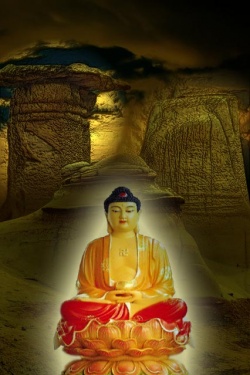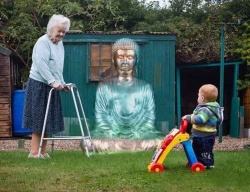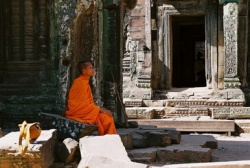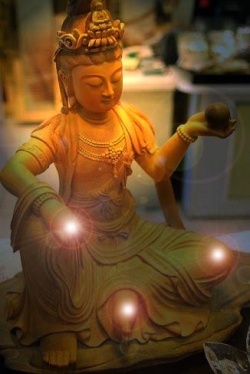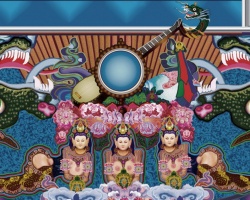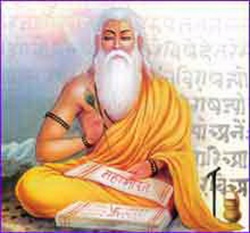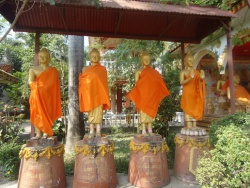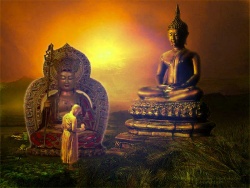Difference between revisions of "When the Ironbird Flies"
m (Text replacement - "ultimate nature" to "ultimate nature") |
|||
| Line 9: | Line 9: | ||
Question: Your Holiness, here in {{Wiki|Dharamsala}} and also on your visits to the [[West]] you have had considerable [[contact]] with {{Wiki|western}} [[people]], who at present are showing a deep [[interest]] in the [[Tibetan]] [[spiritual]] [[traditions]]. Whenever the [[Buddhadharma]] has been absorbed into a new {{Wiki|society}}, it has always been modified so as to have the greatest impact on the [[minds]] or the [[people]]. What can and what cannot be modified, particularly in context to [[Dharma]] in the [[West]]? | Question: Your Holiness, here in {{Wiki|Dharamsala}} and also on your visits to the [[West]] you have had considerable [[contact]] with {{Wiki|western}} [[people]], who at present are showing a deep [[interest]] in the [[Tibetan]] [[spiritual]] [[traditions]]. Whenever the [[Buddhadharma]] has been absorbed into a new {{Wiki|society}}, it has always been modified so as to have the greatest impact on the [[minds]] or the [[people]]. What can and what cannot be modified, particularly in context to [[Dharma]] in the [[West]]? | ||
| − | Answer: The fundamentals of the principal practices of [[Dharma]] ought not to be changed. For example, the bases of [[Bodhicitta]] (the {{Wiki|altruistic}} [[attitude]] of` striving for [[Buddhahood]] as a means of benefiting all [[beings]]) and [[Sunyata]] ([[Emptiness]], the | + | Answer: The fundamentals of the principal practices of [[Dharma]] ought not to be changed. For example, the bases of [[Bodhicitta]] (the {{Wiki|altruistic}} [[attitude]] of` striving for [[Buddhahood]] as a means of benefiting all [[beings]]) and [[Sunyata]] ([[Emptiness]], the ultimate nature of [[mind]] and of all things) will always be required by practitioners. However, in order to get at the [[essence]] of these practices, their secondary details-such as the sequential order of the ways in which they are approached, the specifics of the [[visualizations]] involved in them and so forth-might well be modified to accord with the differing mentalities of given [[people]]. |
There were certain differences in the practices of {{Wiki|ancient India}} and [[Tibet]], yet the [[essential]] factors of [[Bodhicitta]], the core of the [[Mahayana]], were [[identical]]. The differences were only in how [[Bodhicitta]] was actualized. Even in [[India]] there were a number of approaches to it, such as The Exchange of [[Self]]- cherishing for the Cherishing of Others, taught in Santideva's Venturing into the [[Deeds]] of a [[Bodhisattva]] ([[Bodhisattvacaryavatara]]) and The Method of Six [[Causes]] to One Effect, taught in [[Atisha's]] [[Light]] on the [[Path]] (Bodhipathapradipa). These different techniques were meant to suit different circumstances; both aimed at developing the same [[Bodhicitta]] and at outlining the practices of the [[Six Perfections]]. | There were certain differences in the practices of {{Wiki|ancient India}} and [[Tibet]], yet the [[essential]] factors of [[Bodhicitta]], the core of the [[Mahayana]], were [[identical]]. The differences were only in how [[Bodhicitta]] was actualized. Even in [[India]] there were a number of approaches to it, such as The Exchange of [[Self]]- cherishing for the Cherishing of Others, taught in Santideva's Venturing into the [[Deeds]] of a [[Bodhisattva]] ([[Bodhisattvacaryavatara]]) and The Method of Six [[Causes]] to One Effect, taught in [[Atisha's]] [[Light]] on the [[Path]] (Bodhipathapradipa). These different techniques were meant to suit different circumstances; both aimed at developing the same [[Bodhicitta]] and at outlining the practices of the [[Six Perfections]]. | ||
Latest revision as of 15:29, 31 December 2014
An Interview with His Holiness the Fourteenth Dalai Lama
Interview by Mike Hellbach. Translated by Sherpa Tulku. Prepared by Glenn H. Mullin. From Second Dharma Celebration, November 5th-8th 1982, New Delhi, India. First published by Tushita Mahayana Meditation Centre, New Delhi, 1982
Question: Your Holiness, here in Dharamsala and also on your visits to the West you have had considerable contact with western people, who at present are showing a deep interest in the Tibetan spiritual traditions. Whenever the Buddhadharma has been absorbed into a new society, it has always been modified so as to have the greatest impact on the minds or the people. What can and what cannot be modified, particularly in context to Dharma in the West?
Answer: The fundamentals of the principal practices of Dharma ought not to be changed. For example, the bases of Bodhicitta (the altruistic attitude of` striving for Buddhahood as a means of benefiting all beings) and Sunyata (Emptiness, the ultimate nature of mind and of all things) will always be required by practitioners. However, in order to get at the essence of these practices, their secondary details-such as the sequential order of the ways in which they are approached, the specifics of the visualizations involved in them and so forth-might well be modified to accord with the differing mentalities of given people.
There were certain differences in the practices of ancient India and Tibet, yet the essential factors of Bodhicitta, the core of the Mahayana, were identical. The differences were only in how Bodhicitta was actualized. Even in India there were a number of approaches to it, such as The Exchange of Self- cherishing for the Cherishing of Others, taught in Santideva's Venturing into the Deeds of a Bodhisattva (Bodhisattvacaryavatara) and The Method of Six Causes to One Effect, taught in Atisha's Light on the Path (Bodhipathapradipa). These different techniques were meant to suit different circumstances; both aimed at developing the same Bodhicitta and at outlining the practices of the Six Perfections.
Therefore, the details of various practices can differ to suit the western mentality; and not only to suit the western mentality in general but also to suit the individual practitioner's disposition.
Question: All the great masters have stressed the importance of having a spiritual teacher in order to avoid misunderstanding either the teachings or one's meditational experiences. Unfortunately, at present there are few teachers and many who wish to learn. It is advisable for such a person to just read a meditation manual then practise from it?
Answer: This is possible. Certain advanced meditations are dangerous if practised without the guidance of an experienced teacher but simple meditations, such as those on impermanence, love, compassion or the development of samadhi are good.
Without a teacher, it is best to limit oneself to small and simple meditations.
Question: Many people wish to take up a spiritual practice but feel committed to devoting most of their time to job, family, etc. Is it possible to transform these concerns into sources of spirituality?
Answer: The major attitudes one needs to do this are kindness and Bodhicitta.
It is difficult to explain Bodhicitta in brief and still be correct. Perhaps we can say that it is the motivation to help oneself so as to be able to help others. This profoundly kind attitude. Bodhicitta, is the basis of all Mahayana teachings.
To make ordinary activities spiritual, this attitude of kindness must be incorporated within every action of daily life. Certain meditations cannot be practised while you are working, for example in a factory, but meditation upon kindness and compassion can. If you sincerely try. Dharma can always be practised.
Question: The Buddhadharma as practised by Tibetans involves meditation upon a vast array of symbols and deities. Does Your Holiness see this as presenting any problems to the western mind with its monotheistic background?
Answer: This depends on the individual's character. Some people like these deities very much ... (laughter).
Each person must think about what suits him best.
Question: Some say that these symbols and deities should he altered so as to correspond with those of our own culture.
Answer: This cannot be. If you follow Buddhadharma, the deities meditated upon should have a sound reference to the teachings of Buddha Vajradhara. They cannot be arbitrarily created nor can they be blended with those of other methods. It is best to follow with diligence the path most suited to you. If you choose Buddhadharma, practise it purely. Then, if you achieve its results, fine: if you mix practices and achieve nothing, you shouldn't blame Dharma.
Of the various Buddhist meditational deities, the best is Buddha. If you like others, practice them: if you don't, simply take Buddha.
Question: Is this 'liking' due to one's karmic dispositions?
Answer: It has to do with karmic dispositions. Buddhism speaks of idiosyncrasies, latent admirations and underlying tendencies, which together with one's intellect, circumstances and so forth constitute one's karmic dispositions. These are major factors determining which path one should follow.
Question: Many occidental translators of Tibetan texts lay great emphasis upon the external rather than the inner aspects of spiritual magic. How was this problem avoided in Tibet when the tantric texts were translated from Sanskrit into Tibetan?
Answer: This does not seem to have been an excessively great problem in Tibet. However, there undoubtedly have been certain people who did not incorporate Dharma into their mental attitudes. In actuality, anyone who practices tantric methods for such purposes as to destroy an enemy is not really a spiritual person. Whether or not a person is actually a spiritual practitioner is determined by the long-term benefits that his practice brings, not by the methods he uses.
Buddha Vajradhara taught Tantra to help beings attain Enlightenment, not to give them an instrument for harming others. He always emphasized that Tantra is a secret doctrine, for in the hands of someone without the background of Bodhicitta and other qualifications it can be dangerous and not at all beneficial.
In a commentary to the Root Text of Manjushri (Manjushri Mula Tantra) is a story of a Brahmin by the name of Kanaka, who was a practitioner of the Yamantaka Tantra. Although he was an extremely strong meditator with tremendous concentration and power, he fell into hell. His practice, meant to bring him Enlightenment, only harmed him. In a commentary to the Root Text of Guhyasamaja (Guhyasamaja Mula Tantra) the same point is stressed.
Anything that has happened in Tibet along these lines is not good and any such interest elsewhere is the same.
The true tantric practitioner has taken a commitment to not show whatever magical powers he may possess. According to the Vinaya rules, even if you are an Arhant you should not openly reveal your attainments to others. It is the same in Tantra: if you with little reason expose your powers, even though you have certain qualifications, the basis of your practice will degenerate.
Question: Of all Buddhist practices those of the Tantrayana have attracted the most attention among Westerners and not the preliminary tantric practices, but the very advanced, 'Completion Stage' practices involving meditation on cakras, nadis, consorts and so forth. What are the advantages and disadvantages of this interest and what are the preliminaries of tantric practice?
Answer: It is very good that Westerners have this interest in the Completion Stage. However, to perform these is only of little value without first becoming proficient in the practices of the Development Stage (where samadhi is developed and one's attitude towards Tantra matured by means of meditation upon the mystic mandala). Furthermore, this interest should be based on the motivation to benefit all beings: a difficult prerequisite. Interest motivated by mere idle curiosity lacks the proper foundation.
Meditation upon the Completion Stage of Tantra can be extremely dangerous, perhaps bringing many types of sickness and even death to the unqualified practitioner. Medicines cannot cure a sickness arising from performing these practices incorrectly; the only antidote is the proper application of a specific meditation.
Question: In brief, what is the difference between Hindu and Buddhist Tantra?
Answer: To fully understand their differences is extremely difficult. However, in brief, there are differences in both action and philosophy. In terms of action, the Buddhist Tantra is based on the Bodhicitta motivation which the Hindu Tantra lacks. In terms of philosophy, Buddhist Tantra is based on the theory of anatma, or selflessness, whereas the Hindu is based on the theory of a truly-existent self. Other yogas, such as breathing exercises, cakra and nadi practices, have many similarities but subtle differences.
Question: As self-cherishing and ego-holding are forces which have been active since beginingless time, is it possible to set out upon a spiritual path without developing a negative egoism toward it, leading to sectarianism?
To avoid that it is necessary to take care that your Dharma practice is really a Dharma practice. This way, although the power of familiarity with ego is great, its effects are not overwhelming. If you study Dharma but do not actually apply it, your so-called spiritual activities can easily become directed at material gain, fame and so forth. In which case only egoism and such negativities as anger, attachment, sectarianism, etc. are developed. However, if each word of Dharma that you hear is used to cultivate your mind then every single word brings only benefit, and no matter how much Dharma learning you amass your learning will never go to the development of egoism.
The most important point is to be very careful in the beginning with your motivation in receiving a teaching or doing a practice. If this is done well, there is little danger.
Question: Buddha Shakyamuni once said in a Sutra that sectarianism has a karmic consequence more severe than killing a thousand Buddhas. Why is this so?
Answer: The essential purpose of the Buddhas giving teachings is to eliminate both mistaken states of mind and the experience of suffering. This is also the reason that they have worked to achieve enlightenment. The Buddhas' only motivation is to benefit others, which they fulfill by teaching; so despising any of their teachings is worse than despising them. This is the implication of following one Dharma Tradition while disparaging other Traditions.
Furthermore, the Buddhas themselves respect all the Traditions of the Teachings, so for us not to do so is to despise all the Buddhas.
There are many ways to look at this Sutra quotation. What is the duty, so to speak, of a Buddha? Only to teach Dharma. And it is Dharma which has brought that Buddha to his state of attainment. Now, in Buddhadharma we do not accept the theory of a Creator; everything depends on oneself. The Buddhas cannot directly fulfill their wish to help beings, they can only do so through the media of their teachings. We might say that they are handicapped. Therefore, the teachings that they give are more precious and important than they themselves are. Because of the varying capacities and inclinations of beings the Buddhas have taught various methods of practice and philosophy. If we follow one of these and yet belittle others, we abandon the Dharma and consequently the Buddhas as well.
Question: Does Your Holiness think that the various world religions were founded by emanations of the Buddhas manifesting in accordance with the mentalities of the specific societies?
Answer: This is highly possible. The founder of any religion could be an emanation of a particular Buddha. It is for this very reason that we should treat all religions with deep respect.
Question: Then why do these different religions so often fight with one another?
Answer: This is a different matter. For a truly religious person there is never any basis for quarrel or dispute. Yet it is a fact that there have been so-called religious wars. However, the people involved in these were not practising religion but were merely using religion as an instrument of power. The actual motivation was selfish, not spiritual. Religious wars are not a question of contradictions between religions at all.
Leaving aside the disparities between the doctrines of different religions, there are many ostensible contradictions within the teachings of Buddha. For example, for certain reasons some people he taught that there is no truly-existent self, whereas others he taught that there is. So what is a Buddha's purpose in teaching? It is neither to boast nor to demonstrate how much he knows, but to benefit others. Also, he is not concerned with those of his generation alone but with many generations and different kinds of people. Therefore, his teachings must have many different levels of meaning, some often seemingly contradictory. Knowing this, there is never a valid reason for religious quarrels and disputes.
Question: Lama Je Tzong Kha Pa, founder of the Ge-lug Tradition, studied under forty-five gurus representing all the Buddhist lineages of Tibet. Does this mean that within the Ge-lug Tradition we can find all the practices of all the Schools of Tibetan Buddhism and, if not, what was his criterion in selecting lineages?
Answer: Basically, what he did was select the dearest lineage from amongst those available. For example, from the Kagyü he took Guhyasamaja and The Six Doctrines of Naropa, from the Nying-ma he took the lineages held by Lama Lho-dak Nam-kha Gyal-tzen and from the Sa-kya he took the lineages of Vajrayogini, Hevajra, etc.
An extraordinary characteristic of Je Rinpoche's (Je Tzong Kha Pa) teachings is that he relates the explanation that he is giving, such as in his Commentary to Guhyasamaja, to many different traditions, such as the texts on Elucidation of Valid Perception (Pramanavartika), Discipline (Vinaya), The Middle View (Madhyamaka) and so forth. Also, he gives brief explanations of simple points and elaborates on those that are more difficult.
Question: Is this a general characteristic of the Ge-lug Tradition?
Answer: No, I am speaking only of Je Rinpoche. In a way, he is the Ge-lug Tradition, for the Eighteen Volumes of his written works constitute their foundation. Many teachings given by his followers we do not accept.
The same situation exists between the founders and followers in all the Four Tibetan Traditions. There is no difference in the profundity of the teachings of any of the Four Founders, yet within the teachings of the groups of their followers there are endless conflicts.
The First Panchen Lama once wrote, 'Although individual oral traditions have different names, such as The Great Completion, The Great Seal, The Middle Way and so forth, when an experienced yogi with deep understanding of scriptural knowledge and logic examines them he sees them as non- contradictory.'
Question: The traditional scriptures speak of the Three Vehicles. Why did the Buddha teach these three?
Answer: Although the scriptures do speak of Three Vehicles-the Hearer's Vehicle, the Solitary Realizer's Vehicle and the Bodhisattva Vehicle-the first two of these are counted as one, the Hinayana. The Bodhisattva Vehicle, or Mahayana, is subdivided into the Causal Vehicle of the Practice of the Perfections and the Resultant Vehicle of the Practice of Tantra. Thus in Tibet we usually speak of the two vehicles, the Hinayana and the Mahayana.
There are many different ways to look at these two. First we'll consider them from the point of view of practice.
It is very important to have as an external basis the observance of the Vinaya, i.e. maintaining one of the four ordinations of a monk or nun, or either of the two ordinations of a lay person.
For a monk, the three foundations of practice should be followed: Rainy Season Retreat, Monthly Declarations and The Ceremony ending Rainy Season Retreat. These are all Hinayana practices.
In addition to the above, one should take up the practices of compassion, Bodhicitta and the conducts of the Six Perfections, which are Causal Mahayana.
One person can perform all these practices for the attainment of Enlightenment; they do not obstruct one another nor cause any constrictions within the practitioner. Therefore, one person can practice all of them without contradiction. With this approach there can be no basis for Hinayana disparaging Mahayana, Mahayana disparaging Hinayana, Sutrayana disparaging Tantra and so forth. Such is the relationship of the vehicles from the point of view of action.
>From the point of view of philosophy, Buddhadharma can be divided into the Four Schools (Vaibasika, Sautrantrika, Yogacara and Madhyamaka) which all come from India. In one way these seem to be mutually exclusive. However, the purpose of seemingly conflicting teachings within the framework of Buddhist Philosophy is to provide a graduated approach to the higher philosophies, leading to an ever greater, and eventually ultimate, understanding. Therefore, none of the four schools of philosophy is to be abandoned.
In Tibet there are four major Traditions: Nying-ma, Sa-kya, Ka-gyü and Ge-lug. From the point of view of practice, they are all Mahayanists following the unity of Sutrayana and Tantrayana, as described above, on the basis of Hinayana. From the point of view of philosophy, they are all Madhyamikas (who train in accordance with the graduated philosophical stages explained above). They do not differ from the points of view of action or philosophy. Their differences are due to the time of their coming to Tibet, the different lineages of Lamas who have introduced them, the different emphasis on the various aspects of practice and the terminologies by which their teachings are transmitted. All four lead to Buddhahood. Therefore, it is absolutely wrong to say one is better than another, or to disparage any of them.
Question: Would you please Elucidate the difference between Buddhist chanting and, for example, Christian prayer? Also, what is the difference between worshipping Gods and worshipping Buddhas and Bodhisattvas?
Answer: Most of the prayers that we recite contain meanings to be reflected upon. This type of chanting is not done to request or invoke the compassion of the Buddhas but is a method of meditation, the content of the chant being the object of meditation.
However, there is a type of chant which is done to invoke the compassionate attention of the Buddhas. The difference between this and worshipping a god is determined by the motivation and the recognition of what one is doing. Whenever a Mahayana Buddhist makes an offering or a prayer to the Buddhas or Bodhisattvas, he is asking guidance and aid to attain Enlightenment for the benefit of all sentient beings.
Question: In conclusion, does Your Holiness have any general advice for practitioners in the West?
Answer: It is important to think very well before entering a particular spiritual tradition. Once you have entered one you should stick to it. Do not be like the man who tastes food in all the different restaurants but never actually gets down to eating a meal. Think carefully before adopting a practice; then follow it through. This way you will get some results from even dedicating a little time each day. Alternatively, if you try to follow all the various paths you will not get anywhere.
Also, patience in practice is required. In this age of machines everything seems to be automatic. You may think that it is the same with Dharma-that by merely turning on a switch you will gain realization. Be patient. The development of mind takes time!
You should try to maintain a steady effort in practice. It is useless to try very hard for a few months, then give up this kind of application and then try very hard again. It is best to exert yourself in a constant and steady way. This is extremely important.
If you have adopted Buddhism you should not consider yourself a 'great Buddhist' and immediately start to do everything differently. A Tibetan proverb states, 'Change your mind but leave your appearance as usual.'
In all of Buddhism and especially in the Mahayana, the benefiting of others is heavily stressed. In this context Shantideva says in Venturing into the Deeds of a Bodhisattva, 'First investigate what is acceptable and what is unacceptable to the people (of the society in which you live); then avoid that which is unacceptable.' Of course, you must consider whether or not what is acceptable and unacceptable is in contradiction with the Dharma. If the social norm does not contradict Dharma you should try to live in accordance with it. In this way people will respect you. This is not done out of vanity but in order to bring the maximum benefit to all.
In Dharma practice it is necessary to always keep an attitude of love toward others, for this is the basis of Bodhicitta. Love is a simple practice, yet it is very beneficial for the individual who practices it as well as for the community in which he lives, for the nation and for the whole world. Love and kindness are always appropriate. Whether or not you believe in rebirth, you will need love in this life. If we have love, there is hope to have real families, real brotherhood, real equanimity, real peace. If the mind of love is lost, if you continue to see other beings as enemies, then no matter how much knowledge or education you have, no matter how much material progress is made, only suffering and confusion will ensue. Beings will continue to deceive and overpower one another. Basically, everyone exists in the very nature of suffering, so to abuse or mistreat each other is futile. The foundation of all spiritual practice is love. That you practice, this well is my only request. Of course, to be able to do so in all situations will take time, but you should not lose courage. If we wish happiness for mankind, it is the only way.
